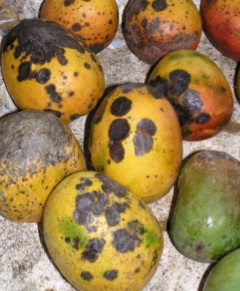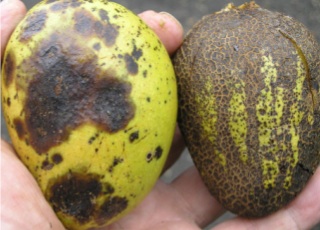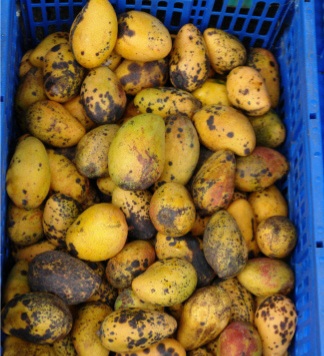Anthracnos: Colletotrichum gloeosporioides
Symptoms:
- Infection occurs leaves, stems, young flowers and fruit
- Sunken black spots appear on the surface of the fruit during ripening.
- Infection – fruit is usually latent and manifests itself only as the mango begins to ripen
- The disease is most severe – wet weather.
 |
 |
 |
| Sunken black spots |
Severely affected fruits |
Infected fruits |
Mode of spread and survival:
- Inoculum remains on dried leaves, defoliated branches, mummified flowers and flower brackets.
- Spread through air-borne conidia
- The fungus can enter the pores of green fruits.
- The latent infection of mature fruits may take place through lenticles.
- The fungus apparently infects the fruits - green and develops in flesh during ripening.
- The latent infection is carried from the field to storage.
Epidemiology:
The optimum temperature - 250°C and relative humidity from 95 to 97 per cent.
Management
Pre-harvest control
- Spray with mancozeb (800 g/kg at 2 g/L) weekly during flowering and then monthly until harvest. Stop spraying 14 days before harvest. During dry weather, flower sprays may be reduced to fortnightly intervals.
- Should rain occur during flowering, apply prochloraz (462 g/kg) (Octave, registered trade mark), using 1 g product/L in a tank mix with mancozeb. Prochloraz only needs to be applied every 3-4 weeks.
- Copper oxychloride sprays (4 g/L) used for bacterial black spot control also control anthracnose, however copper oxychloride should not be used during flowering. Where bacterial black spot is serious, copper oxychloride can be substituted for mancozeb sprays after flowering.
Postharvest control
Hot carbendazim
- Hot carbendazim (registered trade mark Spin Flo, manufactured by Aventis ) is registered for postharvest treatment of mango in Queensland, Northern Territory, Western Australia and New South Wales. Spin Flo is a liquid formulation containing the active ingredient carbendazim.
- Dip fruit within 24 hours of harvest by totally submerging them for 5 minutes in hot water (52°C) to which has been added 100 mL product /100 L water. Lowering the temperature of the dip below 52°C will reduce the effectiveness of the treatment.
- Temperature must be carefully controlled to within 0.5° to prevent fruit damage. Use an accurate thermometer to monitor temperatures in various parts of the dip during use, especially near the heat source.
- Many growers use specially designed tanks heated by gas or electricity with manual or thermostatic temperature control. With an approximate ratio of 3 litres of dip to 1 kg of fruit, no appreciable temperature drop occurs when fruit is added to the tank. This dip also partially controls stem end rot.
Notes on dipping
- Vigorous agitation before and during dipping by means of a powerful recirculating pump is recommended to keep the fungicide suspended. This is preferable to stirring or paddling. Agitation also helps distribute heat from the heating element.
- Bleed sap from fruit before dipping. Mango sap affects the stability of the fungicide suspension.
- Replace the dip once it becomes contaminated by sap and dirt or after 3 days continuous use or after 4000 trays have been treated. Prewashing fruit helps to prolong dip life.
- Dipping temperatures should not exceed 52° as this may result in skin damage. Allow fruit to cool before brushing. During wet weather, reduce the dipping temperature to 50° as susceptibility to skin damage increases. Disease control will be reduced at these lower temperatures.
Unheated prochloraz
Unheated prochloraz (Sportak, registered trade mark) spray to control anthracnose can be used as an alternative to dipping in hot carbendazim (Spin Flo).
- Prochloraz is not effective against stem end rot.
- Apply prochloraz 45% at 55 mL/100 L of water at ambient temperature. Prochloraz has been approved for use only as a non-recirculated spray over fruit. Complete coverage of the fruit is essential for effective control.
- Postharvest treatments will not provide complete disease control.
Image Source: S.C.Nelson. 2008. Mango anthracnose (colletotrichum gloeosporioides). Plant Disease. 1, pp: 1-9. |



